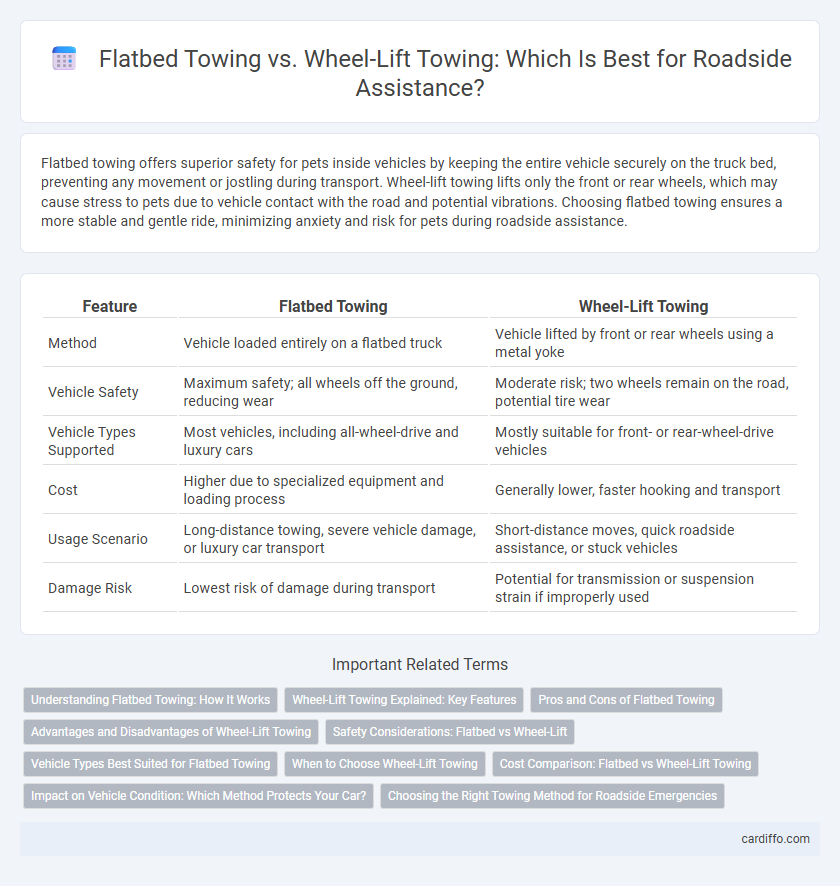Flatbed towing offers superior safety for pets inside vehicles by keeping the entire vehicle securely on the truck bed, preventing any movement or jostling during transport. Wheel-lift towing lifts only the front or rear wheels, which may cause stress to pets due to vehicle contact with the road and potential vibrations. Choosing flatbed towing ensures a more stable and gentle ride, minimizing anxiety and risk for pets during roadside assistance.
Table of Comparison
| Feature | Flatbed Towing | Wheel-Lift Towing |
|---|---|---|
| Method | Vehicle loaded entirely on a flatbed truck | Vehicle lifted by front or rear wheels using a metal yoke |
| Vehicle Safety | Maximum safety; all wheels off the ground, reducing wear | Moderate risk; two wheels remain on the road, potential tire wear |
| Vehicle Types Supported | Most vehicles, including all-wheel-drive and luxury cars | Mostly suitable for front- or rear-wheel-drive vehicles |
| Cost | Higher due to specialized equipment and loading process | Generally lower, faster hooking and transport |
| Usage Scenario | Long-distance towing, severe vehicle damage, or luxury car transport | Short-distance moves, quick roadside assistance, or stuck vehicles |
| Damage Risk | Lowest risk of damage during transport | Potential for transmission or suspension strain if improperly used |
Understanding Flatbed Towing: How It Works
Flatbed towing involves loading the entire vehicle onto a flatbed truck, ensuring all wheels are off the ground, which prevents damage to the vehicle during transport. This method is ideal for long-distance towing, severely damaged cars, or vehicles with all-wheel drive, as it reduces wear and risk of drivetrain damage. Compared to wheel-lift towing, flatbed towing offers superior safety and protection for fragile or high-value vehicles.
Wheel-Lift Towing Explained: Key Features
Wheel-lift towing uses a metal yoke to lift the vehicle by its wheels rather than supporting the entire vehicle on a flatbed, making it quicker and more efficient for short-distance tows and vehicles with a clear, strong frame. This method reduces the risk of body damage on cars without all-wheel drive while allowing for easier navigation in tight spaces compared to flatbed towing. Wheel-lift towing is preferred for its cost-effectiveness and speed, especially in roadside assistance scenarios where time and minimal vehicle contact are critical.
Pros and Cons of Flatbed Towing
Flatbed towing offers superior safety by keeping the entire vehicle off the ground, preventing tire and drivetrain damage during transport. It supports a wider variety of vehicle types, including all-wheel-drive and luxury cars, reducing the risk of mechanical issues. However, flatbed towing is typically more expensive and less accessible in tight or crowded spaces compared to wheel-lift towing.
Advantages and Disadvantages of Wheel-Lift Towing
Wheel-lift towing offers the advantage of quicker hook-up times and reduced vehicle contact, minimizing potential damage compared to traditional flatbed towing. However, it has limitations in towing all-wheel-drive or low-clearance vehicles, where the rear or front wheels are lifted, potentially causing drivetrain or undercarriage damage. This method is more cost-effective for shorter distances but less versatile than flatbed towing, which can safely transport a wider variety of vehicles without risking mechanical harm.
Safety Considerations: Flatbed vs Wheel-Lift
Flatbed towing offers superior safety by fully securing vehicles, reducing the risk of damage during transport and minimizing road hazards caused by dragging wheels. Wheel-lift towing elevates either the front or rear wheels, which can strain the suspension and drivetrain, making it less ideal for all-wheel-drive or low-clearance vehicles. Choosing flatbed towing enhances overall safety for both the vehicle and other motorists on the road.
Vehicle Types Best Suited for Flatbed Towing
Flatbed towing is best suited for vehicles with low ground clearance, such as sports cars, luxury sedans, and electric vehicles, as it prevents damage to the undercarriage during transport. Heavy-duty trucks, classic cars, and motorcycles also benefit from flatbed towing due to the need for full suspension support and secure immobilization. In contrast, wheel-lift towing is more appropriate for standard passenger cars and light trucks that can withstand partial lifting without risking drivetrain or suspension damage.
When to Choose Wheel-Lift Towing
Wheel-lift towing is ideal for vehicles with low ground clearance or those that cannot sustain being lifted entirely off the ground without risking damage. This method is especially suitable for short-distance tows in urban settings where maneuverability and speed are crucial. Choose wheel-lift towing when quick, efficient roadside assistance is needed without the expense or complexity of full flatbed equipment.
Cost Comparison: Flatbed vs Wheel-Lift Towing
Flatbed towing typically costs more than wheel-lift towing due to the specialized equipment and increased labor required to load and secure vehicles onto the flatbed. Wheel-lift towing is generally less expensive because it lifts only two wheels of the vehicle, reducing operational time and complexity. Choosing between flatbed and wheel-lift towing depends on vehicle type, distance, and damage risk, with flatbeds offering safer transport for all-wheel-drive or high-value vehicles despite the higher cost.
Impact on Vehicle Condition: Which Method Protects Your Car?
Flatbed towing minimizes damage by securely lifting the entire vehicle off the ground, preventing wear on tires, suspension, and drivetrain components. Wheel-lift towing only raises two wheels, potentially causing strain on the vehicle's alignment and undercarriage, especially for all-wheel or rear-wheel drive cars. Choosing flatbed towing offers superior protection for vehicle condition, reducing the risk of costly repairs after transport.
Choosing the Right Towing Method for Roadside Emergencies
Flatbed towing offers superior safety for transporting all-wheel-drive and luxury vehicles by fully securing the entire vehicle on a flat platform, minimizing damage during roadside emergencies. Wheel-lift towing is faster and more cost-effective, ideal for short distances and vehicles with rear-wheel or front-wheel drive without complex drivetrains. Selecting the right towing method depends on vehicle type, towing distance, and urgency, ensuring damage prevention and efficient roadside service.
flatbed towing vs wheel-lift towing Infographic

 cardiffo.com
cardiffo.com